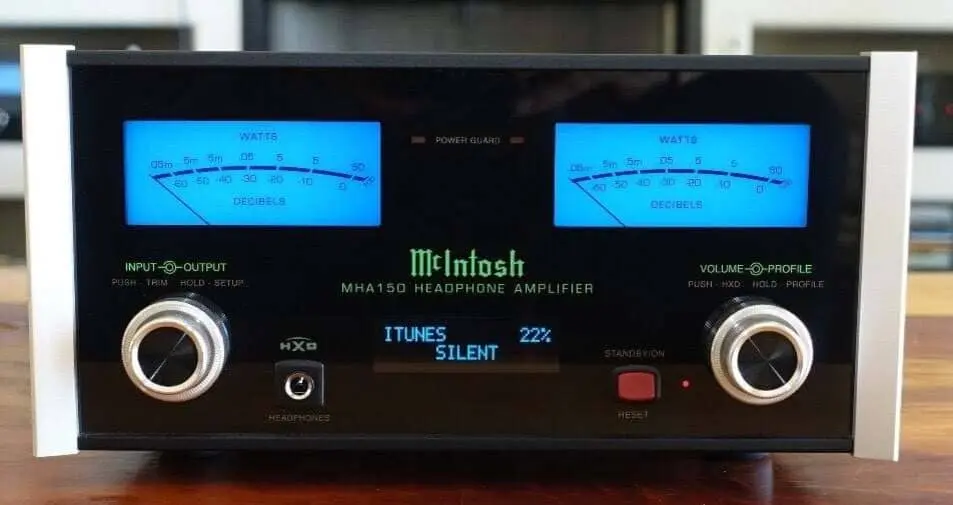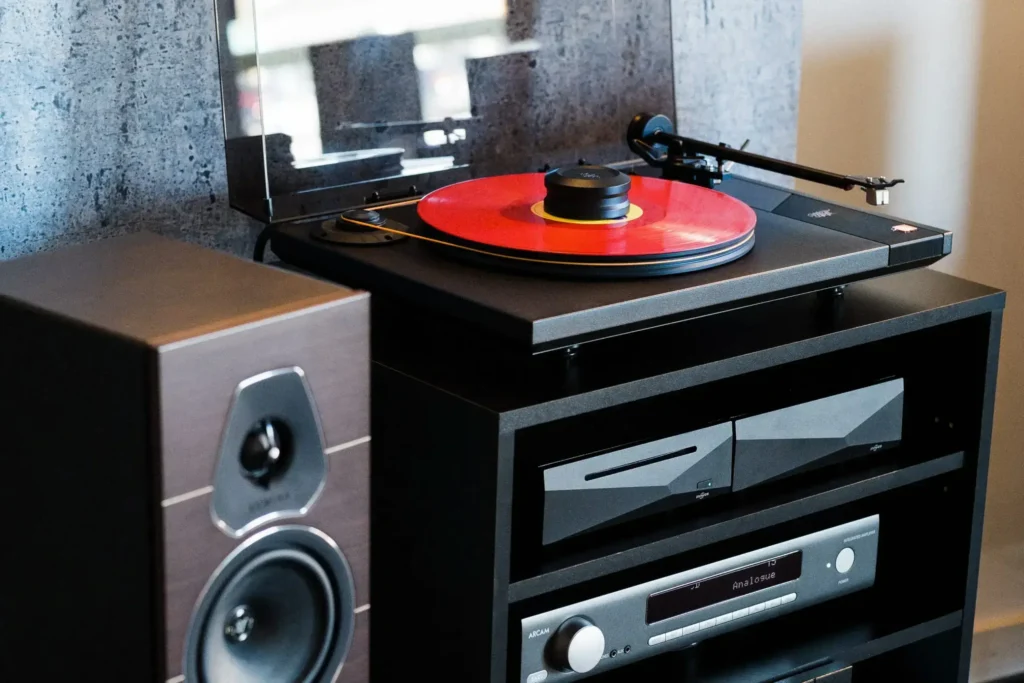The MHA150 Headphone Amplifier is a worthy sequel to the critically acclaimed MHA100. The MHA150 has the same features and performance standards as its predecessor, but it also has a new second-gen digital-to-analog converter (DAC) that supports DSD and DXD files, which gives you access to the latest in digital music. In this article, we will discuss the overview of
McIntosh mha150 and also examine all other details of it. So Let’s Get started:
Design
The MHA150 is a multi-faceted integrated amp that can drive speakers at a robust 50 watts per channel. It has one pair each of RCA and XLR inputs, plus a single unbalanced output for an external amp or subwoofer. It’s smaller than the McIntosh MA5300 integrated or C49 preamplifier. It’s only 11.5 inches wide versus the full 17.5 inches of those components. Plus, its built-in DAC reduces the need for multiple analog inputs. McIntosh MHA 150 Amplifier

The MHA150 has an ESS DAC chip that takes in USB, coaxial, TOSLINK, and MCT link inputs. It can handle high-res PCM up to 24-bit/192kHz, while USB goes up to 384kHz with PCM and DSD256. The MCT link also works with DSD signals from SACD media when you use a compatible McIntosh transport like the MCT80.
The headphone output is a key feature. It has a 1/4″ socket and a transformer coupling that uses McIntosh Autoformers. That means it can handle a lot of different kinds of headphones. The menu lets you choose low, medium, or high impedance options, and you can toggle between normal and high output. There’s also an HXD crossfeed option that tries to make the sound more like a blended speaker.
If you thought that was a lot, there are also a bunch of trim options for pairing with lower or higher voltage analog signals. You also get a 5-stage bass boost in 2.5dB increments centered around 40Hz. They also threw in stereo/mono switching and a left/right balance adjustment that works with both the headphone and speaker outputs. In other words, they’ve given you a ton of ways to achieve harmony with your gear and your preferences.
Sound quality
This headphone amp is a small box that puts out a lovely, lush sound. It’s hard to dislike. It sounds smooth but not lifeless. It gives you a lot of detail cohesively and musically. McIntosh MHA 150 Amplifier
We tested the MHA200 amp by listening to Beethoven’s Moonlight Sonata.
The amp gave the piano a solid, authoritative sound. The instrument’s rich harmonics came through with all the textures and dynamics intact. We loved the way this amp communicated the quiet space between notes and tied them together with such musical conviction.

The MHA200 amp has a full-bodied, slightly rich sound that isn’t too distracting. Compared to other amps we’ve heard, it sounds solid and three-dimensional. When we switched to music that needed more kick, the MHA200 delivered a punchy, powerful sound that captured the essence of the music. The amp has an impressive level of resolution, which lets us track low-level instrumental strands easily. Drake’s distinctive drawl comes through loud and clear with a natural warmth.
This amp doesn’t have a lot of rhythmic drive, but it still sounds good. It’s got enough drama and punch to keep things interesting. McIntosh MHA 150 Amplifier
Features
- hybrid high-output headphone amp and stereo integrated amp
- rock-solid stainless steel chassis and illuminated glass front panel
- analog and digital inputs to handle a variety of music sources
- advanced digital-to-analog conversion using a series of upgraded built-in DACs
- 32-bit/192kHz decoding for enjoying high-resolution digital music files
- plays DSD files at 2.8MHz or 5.6MHz
- full-size headphone output with selectable impedance to match your headphones
- choose between three impedance ranges: 8-40 ohms, 40-150 ohms, and 150-600 ohms
- McIntosh’s Headphone Crossfeed Director (HXD®) circuitry adds spaciousness and depth
- stereo integrated amplifier
- 50 watts x 2 into 8 ohms (20-20,000 Hz) at 0.005% THD with two channels driven
- Power Guard® circuitry protects speakers and headphones from damaging volume spikes
- 5-step bass boost control allows custom tone shaping
- uses a special version of McIntosh’s patented Autoformers to ensure stable operation
- ThermalTrak™ output transistors for low distortion and cool operation
- fiber optic illuminated glass front panel and mirror-finish stainless steel chassis for a beautiful appearance and long-term durability
- display and meter backlight can be turned off
- handcrafted at McIntosh’s Binghamton, New York factory
Specifications
HEADPHONE OUTPUT SPECIFICATIONS
- Headphone Power Output:
- – High Selection: 1W
- – Normal Selection: 250mW
- Headphone Output Impedance:
- – 8-40 Ohms
- – 40-150 Ohms
- – 150-600 Ohms
ELECTRONIC SPECIFICATIONS
- Power Output per Channel: 50 Watts
- Speaker Impedance8 Ohms
- Rated Power Band:20Hz to 20kHz
- Total Harmonic Distortion: 0.005%
- Intermodulation Distortion: – 0.005% maximum, if the instantaneous peak power is 100 watts or less per channel with both channels operating for any combination of frequencies from 20Hz to 20kHz
- Dynamic Headroom: 1.5dB
- Frequency Response: +0, -0.5dB from 20Hz to 20kHz, +0, -3dB from 10Hz to 100kHz
- Sensitivity (Unbalanced): 300mV
- Sensitivity (Balanced): 600mV
- Maximum Input Signal (Unbalanced): 8V
- Maximum Input Signal (Balanced): 16V
- Signal To Noise Ratio: 105dB
- Input Impedance (Balanced / Unbalanced): 25K/25K
- Damping Factor: >150
- Preamplifier Output: 3V (8V maximum)
- Preamplifier Output Impedance: 500 Ohms
- Voltage Gain: 36.5dB
- Power Guard: <2% THD with up to 16dB overdrive at 1kH
CONNECTIVITY
- Headphone Output: – 1/4″ High Drive with Headphone Crossfeed Director (HXD)
- Balanced Input: 1
- Unbalanced Input: 1
- Digital AES/EBU Input: 0
- Digital Coaxial Input: 1
- Digital Optical Input: 1
- Digital MCT (DIN) Input: 1
- Digital USB Input: 1
- Preamplifier Output: 1
DIGITAL AUDIO SPECIFICATIONS
- Digital AES/EDU Input Sample Rate: N/A
- Digital Coaxial Input Sample Rate: – 16-bit, 24-bit – 32kHz to 192kHz
- Digital Optical Input Sample Rate: – 16-bit, 24-bit – 32kHz to 192kHz
- Digital MCT (DIN) Input Sample Rate: – 16-bit, 24-bit – 32kHz to 192kHz
- Digital USB Input Sample Rate: -16-bit, 24-bit, 32-bit – 32kHz to 384kHz
CONTROL
- Tone Controls: – 5 Step Bass Boost Control: 0 to +12.5dB (in 2.5dB steps) @ 40Hz
- Power Control Input: 1
- Power Control Output: 1
GENERAL SPECIFICATIONS
- Output Meters: Yes
- Vacuum Tube or Solid State: Solid-State
- Power Requirement: 120V 50/60Hz, 1.5A
- Standby Power Requirement: <0.25 Watts
- Output Type: – Autoformer™ for Headphones,- Direct Coupled for Speakers
WEIGHTS & DIMENSIONS
- Unit Dimensions (W x H x D): – 11-1/2″ (29.2cm) x 5-7/8″ (14.9cm) x 14-5/8″ (37.1cm)
- Unit Weight: 26.5 lbs (12 kg)
- Shipping Weight: 32.5 lbs (14.8 kg)
Conclusion
This headphone amp is the best of the best when it comes to refinement and lack of unwanted hardness. It’s a product that invites long listening sessions and can be enjoyed for years to come. If you’re looking for a top-notch headphone amp, few are as capable or as charming as this one at this price point. McIntosh MHA 150 Amplifier



